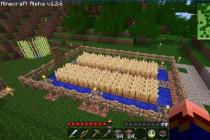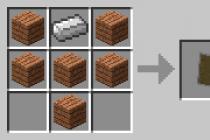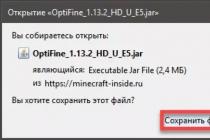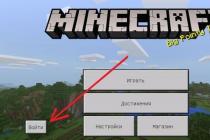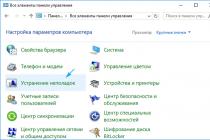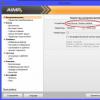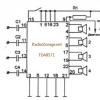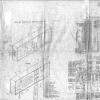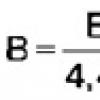Material from the Family Navigator
OBD "Memorial"- a generalized electronic data bank (OBD) containing information about Soviet soldiers who died, died and went missing during the Great Patriotic War, as well as in the post-war period. The database was created by the Ministry of Defense of the Russian Federation (Ministry of Defense of Russia), the technical part of the project was implemented by the Electronic Archive Corporation.
Since 2007, it has been in the public domain on the Internet at: http://www.obd-memorial.ru. Flash 9 is required to view the database.
History of creation
Work on the OBD "Memorial" was started in accordance with the List of Instructions of the President of the Russian Federation dated April 23, 2003 No. pr-698 on the organization of military memorial work in the Russian Federation and Decree No. 37 dated January 22, 2006 "Issues of perpetuating the memory of those killed during defense of the Fatherland".
- In 2006-2008, the Military Memorial Center of the Armed Forces of the Russian Federation (Russian Armed Forces) carried out work that was unique in scale, technology and deadlines, as a result of which an information and reference system was created that has no analogues in world practice. OBD was created by scanning, processing and entering into the Internet information retrieval system archival documents stored in the Central Archive of the Russian Ministry of Defense and in the Military Memorial Center of the Russian Armed Forces.
- By 2008, within the framework of the project, about 10,000,000 sheets of archival documents and over 30,000 passports of military graves were scanned and made available on the Internet. The personal information contained in them amounted to more than 20,000,000 records (often several records refer to the same person).
- In 2008, the second stage of work began: clarifying information on specific persons and combining records from different sources related to one person. Thanks to the feedback system, Memorial users can also report inaccuracies in the database or send their additions.
In the future, the OBD is planned to be supplemented with information relating to the dead and missing soldiers during other military conflicts of the 20th century, which is stored in the archives of the Russian Federation.
Presentation of information in OBD
The main goal of the project is to enable millions of citizens to determine the fate or find information about their dead or missing relatives and friends, to determine the place of their burial. In the course of the creation of the Memorial OBD, funds 58 and 33 (“Reports of combat units on irretrievable losses” and a card file for registering Soviet prisoners of war) stored in the TsAMO of Russia, as well as documents from the “Passports of Burials” fund stored in the VMTs Armed Forces of Russia were processed.
The main array of processed documents are:
- reports of combat units on irretrievable losses,
- other archival documents specifying the losses (funerals, documents of hospitals and medical sanitary battalions (medical battalions), trophy cards of Soviet prisoners of war, etc.),
- burial passports of Soviet soldiers and commanders (officers).
Each entry in the OBD contains the last name, first name, patronymic, date of birth, date of departure and place of birth of the serviceman (provided that all of them are indicated in the document). Moreover, the site contains scanned copies of all source documents containing information about persons. They often contain additional data, including the names and addresses of relatives to whom the funeral was sent.
Access restriction problem
From January 28, 2010, access to some information about personalities was limited due to the entry into force of Federal Laws of June 27, 2006 No. 152-FZ “On Personal Data” (as amended, Article 9 and Article 19), and also dated October 22, 2004 No. 125-FZ “On Archiving in the Russian Federation” (as amended by Article 25). As reported on the WDS website, information that could serve as a reason to belittle the dignity of the person, honor and reputation of soldiers (about people who went over to the side of the German troops, about those convicted by a military tribunal, etc.). was replaced with general wording (“sent to the front line” and another reason for leaving, death), and access to viewing electronic copies of documents was limited, on which, in addition to the specifically wanted warrior, you can see information on other people with the above reasons for leaving.
This measure caused a wide discussion, soon a letter was published on the Soldat.ru website to the President of Russia D. A. Medvedev with a request to look into the situation and restore users' access to OBD information. The letter was signed by the search engines of Russia, the CIS countries and the Baltic States, relatives of the dead and missing soldiers, and members of the public. Several thousand signatures were left under the letter on the Soldat.ru website, as well as on the forum of the VGD website, and the letter was also posted on the President's blog.
On February 9, 2010, the news program of the NTV channel showed a story about the closure of some information in the OBD; In an interview with an NTV correspondent, Alexander Kirillov, head of the Russian Defense Ministry's Directorate for Perpetuating the Memory of Those Who Died in Defense of the Fatherland, said that the department plans to deal with the situation during February, since "the database was not created to host and close it."
At the beginning of March 2010, a message appeared on the OBD website stating that the restrictions on working with information had been lifted, since the Main Legal Directorate of the Russian Ministry of Defense analyzed this issue and decided that the information on the Memorial website was not subject to the above laws and free access it should be restored.
The feat of the Soviet soldier who defeated fascism is difficult to overestimate even in today's difficult times.
The names of many and many heroes remained unknown or forgotten, and the further, the more difficult it is to find traces.
Which could reliably fill in the gaps in the heroic history of the Soviet Union during the Great Patriotic War.
The portal of the Central Archive of the Ministry of Defense of the Russian Federation is called upon to restore the pages of military history, at least with the names of unknown soldiers who have become heroes forever.
The portal of the Central Archive of the Ministry of Defense is an electronic resource available at archive.mil.ru.
Which contains information about documents relating to the course of the war, senior and junior commanders and privates, the composition of armies and smaller structural units.
The scientific department is engaged in the restoration of historical events of those times according to documents and artifacts, which, although rare, continue to be found.

The main purpose of the portal and the Central Archive is to help the relatives of soldiers and officers who participated in hostilities and died in them or went missing.
The portal itself was created in order to facilitate and simplify the submission of a request to the archive about the dead soldiers.
The second no less important goal of the archive is to search for people who at that time were awarded orders and medals for services to the Motherland, but did not have time or for some reason could not receive them.
A separate small subsection of the site is devoted to this, where a list of soldiers and officers who have not been awarded their awards is presented.
This list is small and probably not everyone who still needs to receive their award is indicated in it, but with the advent of new information, it is constantly updated on the site.

The structure of the portal of the Central Archive of the Ministry of Defense
The portal is quite large and has many "structural divisions". It consists, as it were, of three parts, for which their own menu items are provided.

The top menu represents the sections of the archive portal itself. From this menu it is possible to apply for a search for a relative who died in the war.
The scientific reference apparatus, the reading room of the archive are also described, links to electronic resources are given, and contact details are indicated.
Generalized databank "Memorial"
The Memorial Generalized Data Bank project deserves special attention.
It is with its help that you can set a search and find a person of interest who participated in the Great Patriotic War.

The main sources of information that are used for searching are described in the "Sources of Information" section, which is given at the bottom of the page.
- These are reports of personnel losses after large-scale and more local battles;
- Information about the reorganization of troops;
- Descriptions of graves and information about the dead or missing;
- Military medical documentation, other documents;
- Including about prisoners of war of our army and the enemy.
All materials amounted to more than 20 million entries on more than 10 million sheets.
All this information was systematized and brought into electronic form.
To get general brief information about a particular soldier, you need to fill out a search form, which has a short and extended version.
If only the surname, name and patronymic are known, it is sufficient to use the short form.
If you have more detailed data, it is better to use advanced search.

Documents to be searched.

After entering all the known data in the expanded search form at the bottom of the page, you need to click the "Search" button.

Based on the search results, a list of names of soldiers and officers is issued, among which there may be a person of interest.

Note! Despite the fact that this resource was created by the Russian Ministry of Defense, the archive contains information not only about Russians, but also about residents of other former republics, since they all belonged to the same army - the Soviet one.

The icons at the end of each line allow you, respectively, to view summary information about a particular person, view a document, or download its electronic version.
Submission of a request to the archive and electronic reception
You can submit a request to search for information about a person through the "Services" section.

They are divided depending on the affiliation of the person of interest to a particular unit or formation.

The submitted forms are automatically downloaded, they can be printed and filled out manually or filled out electronically, and then printed completed.
There are two ways to submit a request: by mail or in person at the Central Archive of the Ministry of Defense of the Russian Federation.
An electronic application form is also provided, which is filled out online. From the proposed ones, you need to select the appropriate one and click the "Create" button.

After that, a form with required fields will appear.
They need to enter the relevant information, as well as the contact details of the person who makes the request and to whom the response will be sent.

Electronic reception

You can also enter your Personal Account, get help information or read the most popular questions and answers to them.

If it is necessary to send a message or an appeal to the Ministry of Defense, then the citizen must register a Personal Account for himself.
This can be done using the link "Citizen's Personal Account". This link directs to the login form, where there is a link to register.

To register, you need to enter personal data, an email address and come up with a strong password.
After that, you can freely use your personal account.

Military Historical Library and Reading Room
The section "Military Historical Library" provides information about the library itself and its activities, management, announcements about events and activities that are planned in the library.
The "Golden Fund" section contains several links to the most ambitious works on the history of the military glory of Russian weapons, about the military and sailors, and historical personalities.
Note! The site does not present electronic versions of books and printed publications, except for books from the Golden Fund.
However, the latter are read-only, not downloadable.
The library also presents small exhibitions of military uniforms of soldiers of the Russian army from different times.
The section of the portal "Reading Room" contains instructions on using the exhibits of the reading room, working with documents and literature, and the procedure for making copies of documents.
Attention! The reading room is open only on certain days, and in order to work with documents, you must first make an application.
Other sections of the portal
The portal is a rather large and complex structure.
Some of its sections carry reference and informational information, and the literary and documentary fund is not directly available online.
The other part is in the nature of searching and educating patriotism and a sense of historical memory and the feat accomplished by our ancestors.
For a more detailed study of all the possibilities of the portal or the solution of a specific issue, you need to devote more time and, possibly, contact the user support service.
Attention! All information on this website is provided for informational purposes only. The site does not collect and process personal data. Federal Law of July 27, 2006 N 152-FZ "On Personal Data" is not violated.
The Memorial website was developed in 2007 on the initiative of the Ministry of Defense of the Russian Federation. To date, the Memorial OBD archive contains about 17 million digital copies of documents on irretrievable losses, as well as about 20 million nominal records on the losses of the Red Army in the Great Patriotic War.
The primary burial sites of more than 5 million soldiers and officers have been made public.
If you need to find your relatives who were participants in the Great Patriotic War, then use the Memorial website. To do this, you will need to go to the following Internet address: www.obd-memorial.ru.
On the main page of the site, the opportunity is provided to "Set the fate" of a participant in the Great Patriotic War.
Set fate To do this, you will need to indicate the following information about the wanted person: last name, first name, patronymic, year of birth, title. After filling in the above information, click on the "Search" button. You can search on the website "Memorial" of the Ministry of Defense and only by the name of the missing person.
Next, the computer will look for matches between your entered data and the Memorial website database. After the search, the computer will give you the results. Based on the search result, you can find out the following data about the wanted person: place of birth, date and place of conscription, last place of service, military rank, reason for leaving, date of leaving, primary place of burial.

Search resultsIf nothing was found for your query, then use the advanced search. With it, you can set more parameters for the search, and thereby increase the likelihood of a positive search result. During an advanced search, it is possible to set the following search parameters: full name, last name in Latin, date of birth, place of birth, date and place of conscription, last place of service, military rank, camp number, date of departure, country of burial, region of burial, place of burial, place of departure, hospital where he was reburied, place of captivity, date of death. It also provides the ability to specify lists in which to search first.

Advanced search On the site memorialIf you still couldn't find anyone, don't despair. The site database is updated annually with new entries. In 2015 alone, 250,000 documents clarifying losses were processed, of which more than 3 million records were entered on personalities; places of departure of fighters who died on the battlefields were published. Thanks to the Memorial project, relatives and friends can put new names of fallen soldiers and officers on the monuments and thereby restore the memory of the feat of fathers, grandfathers and great-grandfathers.
At present, thanks to the digitization of documents, the names of 1 million military prisoners of fascist camps have been restored. However, according to German data, the total number of Soviet citizens in captivity exceeded 5 million, which means that more than 4 million names have been forgotten and erased from history. The Memorial project has been operating for 10 years. During this time, he restored the name and memory of many who disappeared in the war. To date, the project continues to function under the slogan: "No one is forgotten, nothing is forgotten."
Online consultants are available on the Memorial website on weekdays from 9:00 to 18:00 Moscow time, by contacting which you can get answers to your questions about the operation of the site. To ask a question, you need to click on the "Feedback" tab on the main page of the site. After that, you will be redirected to a new page of the site, where you can ask a question. To ask your question, you also need to provide the following personal information: full name, email address, city and region, place of work, position. After filling in the required personal information, you can start writing a question, and you also need to select a topic for the question.

Online consulting The answer to your question will be processed for some time, and after processing you will receive it to the specified e-mail address.
The curator of the Memorial project is the Directorate of the Ministry of Defense of the Russian Federation for perpetuating the memory of those who died defending the Fatherland.
The main goal of this project is to enable millions of citizens to determine the fate or find information about their dead or missing relatives and friends, to determine the place of their burial.

Perpetuating the memory of participants in the WWII using the Memorial website, you can establish the burial place of your relatives, who involuntarily became participants in the Great Patriotic War.
To search for information, you need to fill out a given template.
Letter case does not matter.
In each field, you can use the asterisk symbol, which means that any characters can follow from this place in the search text. For example, when setting an expression in the Surname field, a search will be performed for all surnames starting with - Ivanov, Ivanovsky, etc., when setting - all surnames containing a substring - not only Ivanov, but also Selivanovsky, etc.
We advise you to always use the asterisk character at the end of the searched text, this will increase the chance of finding entries with spelling variations.
In some lists, the names of the dead are typed in Latin.
In some lists, double full names are indicated (in brackets or with a hyphen). To search in such records, use the asterisk character at the beginning and end of the search text.
The search result is displayed as a list of 20 people per page, the number of found records will be indicated above the list, and the number of pages of the list below the list. You can go to the desired page by typing its number in the corresponding window. The list shows only a part of information about a person, to view all available information about him, you need to click on the -> icon.
To navigate in the window for viewing information about an individual, you can use the arrow keys, PageUp and PageDown (go to the page up and down, respectively), the key combination Ctrl + Home and Ctrl + End (go to the beginning and end of the document, respectively). To return to the list of found surnames, you need to click on the "Return to search results" button at the bottom of the window.
Search also in the Generalized Data Bank of the Ministry of Defense of the Russian Federation (OBD "Memorial") www.obd-memorial.ru
Databases migrated in 2017 to the new site. Added the ability to search by different fields of directories. Accelerated and added new search capabilities in the summary database.
.
To organize in archivessearch for dead and missing in the Second World War 1941-1945 relatives by last name is necessary
1) Collect as much information as possible about the wanted front-line soldier (last name, time / place of birth; region of conscription into the army; place (s) of service; branch of service; number (s) of the unit (s); any official and unofficial hit notifications captured; field mail numbers from sent letters, etc.)
2) Apply with all these data to the Internet sites:
a) a thematic resource of the Ministry of Defense called "Memorial United Data Bank"*. Address: www.obd-memorial.ru
b) electronic bank "Feat of the people in the Second World War 1941-45"
Includes numbers and texts of award orders. Address: http://podvignaroda.mil.ru/?#tab=navHome.
c) "Memory of the people"
This resource contains information about the locations of military units at all stages of the Second World War. Address: https://pamyat-naroda.ru/.
d) "Immortal Regiment"
The sites of the public initiative moypolk.ru and polkrf.ru allow you to search for front-line soldiers in their own database, publications in the media, order numbers, archival documents, stories of WWII participants, etc.
3) Send requests to search for a missing person in the Second World War to unofficial archives and databases collected by public figures (you can find the names of those using Yandex and any other search engine).
4) Contact specialized archives (the capital's State Military Archive and / or similar archives of the former Soviet republics; archives of law enforcement agencies, etc.). When visiting a selected archive in person, you may be required to make a statement indicating your personal data, the purpose of collecting information and an approximate list of requested documents.
5) Send a request for the search for the dead and missing in the Second World War of 1941-1945 to the archives of Germany and the countries in whose territory hostilities were fought. The main building of the Federal Archives of Germany is based in Kobletz, and the largest branches are in Freiburg, Berlin and other cities.
6) Contact the local archives of German cities and lands (Dresden Documentation Center under the organization "Saxon Memorials", etc.)
7) If there is information about the approximate place of death of the wanted relative, contact local military-patriotic detachments, a list of which is available on the Sporf.ru resource (subsection "Region. Representatives").
Algorithm for finding a missing relative
The more data is known about the front-line soldier, the easier it is. Ideally, in addition to the full name of the person you are looking for, it is desirable to have information about the place of his birth, the date and place of conscription, the number of the military unit, etc. As a result of the analysis of documents provided by online resources, one can track the life path of an ancestor. For example, information from award documents will allow you to find out about the feats committed by a relative, the address of the family during the Second World War, etc.
"Missing"
Such a wording in the search results should in no case be the basis for terminating the search. According to the documents about the places of service, you can "calculate" the fellow soldiers of the hero and learn from them the details of the fatal battle. There are cases when fighters who lost their memory "surfaced" under other names. The main thing is not to stop searching, using any, even the most insignificant, "hooks".
It would not be superfluous to establish contacts with representatives of search parties (personal items and remains found by them often allow shedding light on events of interest).
It is important to remember that the fighters who were taken prisoner were recorded among the missing. To search in this direction, it is advisable to contact the Russian Ministry of Defense and the German Documentation Center located in Dresden, where data on citizens of the Soviet Union captured by the Nazis are collected.
How to act in case of failure
Consult with like-minded people and people who have been searching for a long time. From them you can find out the addresses of thematic forums and social networks (some sites are entirely devoted to discussing the front-line life of specific units and formations). The forum of the All-Russian Genealogical Tree website contains links to a great many links and archives, request forms to various departments, search recommendations, etc.
OBD "Memorial"
* The generalized computer data bank "Memorial" is an information archive created on the presidential order No. pr-698 dated April 23, 2003 with information about the defenders of the Motherland, the fallen and missing during the Second World War (1941-1945) and the post-war period.

The mission of the OBD "Memorial" project is to provide citizens with the opportunity to establish the fate and places of burial / captivity / loss of their relatives.
The formation and content of the site www.obd-memorial.ru is carried out by the specialists of the corporation "ELAR".
Data on the soldiers of the Red Army and partisan detachments were collected by employees of the Logistics Service
- - departmental archives (Navy, Air Force, Ministry of Defense, Ministry of Internal Affairs, KGB/FSB);
- - branches of the Russian State Military Archive;
- - branches of the State Archives of the Russian Federation;
- - specialized departments of the Ministry of Defense;
- - open sources (newspaper publications; data of postal correspondence; reports of irretrievable losses; documentation of medical battalions and hospitals; trophy cards of prisoners of war; burial passports, etc.).
The result of this interaction was the creation of a global (and regularly updated) information and reference system with more than 13.4 million digitized pages of archival documents and 42,000 burial passports. OBD "Memorial" - the largest electronic archive missing World War II soldiers war in the world.
On Obd-memorial.ru, millions of scanned copies of primary documentary sources with information about personalities are available for study. Portal visitors can search for the necessary information about veterans online. Access to the portal is open 24 hours a day.
The search for the missing participants in the Great Patriotic War of 1941-1945 can be done on sites (the addresses are indicated above), which have solid databases with the names of fallen soldiers found by search teams. To submit a request, you will need to enter your full name and, if possible, additional information about the wanted person (his age, rank, military awards, etc.). The databases on these portals are constantly updated, so a negative result of the first attempt may turn into a positive one after some time.
An alternative to these sites can be an appeal to regional military-patriotic clubs, the coordinates of which can be found on the Web. The search engines will add a photo of the missing relative with the personal data of the deceased to a common database, after which the same enthusiasts across the country will connect to the search for a fighter.
And finally, you can write (call) to the program "Wait for me", the organizers of which are looking for missing soldiers all over the planet. To get into the database of the project, you will need to fill out a questionnaire on the portal "Poisk.vid.ru". The more information about a missing relative is known, the higher the likelihood of establishing information about him. Search activities begin immediately after the receipt of the questionnaire. According to statistics, Wait for Me employees search weekly for information about several dozen people, about a third of whom are ordinary soldiers, officers and partisans who did not return from the war.
Attention! Due to the large number of incoming applications, processing of new requests is temporarily suspended. You can search on your own in the bases "Memorial" (obd-memorial.ru), "Feat of the people" (podvignaroda.ru) and "Memory of the people" (pamyat-naroda.ru) - the search for them is absolutely free.


